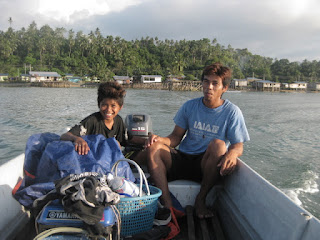
Considered one of the most traditional ethnic groups in Sabah, many Rungus live in longhouses, with each family having its own separate quarters off a common hall. At the edge of the communal hall, a well-ventilated platform of split bamboo with outward sloping walls provides a place for socializing and communal work. The Rungus longhouse is quite different from the Murut longhouse. The houses are not perched on high stilts, but are usually only three to five feet above ground. The roof is low, and the walls are outward sloped. In olden times, longhouses of over 75 doors are said to have been common. Now, they rarely exceed 10 doors. Usually single story, more modern two-story versions of the longhouse also exist. Single family houses are sometimes built near the longhouse – these take the same form, but are curiously short, looking like a slice from a cake
The traditional Rungus dress is black, often with hundreds or even thousands of dollars worth of antique beads. Traditionally all Rungus women wore heavy brass coils around their arms, legs and necks. Brass arm coils are often accompanied by white and coral shell bracelets. Rings of brass may also be worn around the waist.
This beadwork and its designs easily distinguish the Rungus from the other ethnic groups of Sabah. "The beadwork often tells a story and this one in particular tells of a man going spear-hunting for a riverine creature" (Benggon 1992:14). The pinakol consists of a pair of flat beaded bandoleer-type belts worn crossed over the chest and back.
The sandang is a pair of long beaded strands, mostly with matching beads. These are worn crossed over the chest like the pinakol. The sulau is a flat beaded choker worn around the neck with two clamshell discs, one in front and one in back. Small bells are attached in the front. They make the discs out of plastic nowaday The tinggot is a short choker, either single beaded or with narrow beadwork. Men and women wear these. The togkul is a necklace some 26 inches (66 cm) long with beads similar to the sandang but smaller and worn around the neck. The sisingal is a narrow beaded band worn around the head. The rampai is made of cotton, flowers and beads worked into the hair. The orot. "Little brass rings and antique beads looped through thin strands of stripped bark (togung) becomes a wide and colorful hipband. To wear this the orot is slowly and carefully coiled around the hip. Then a last string of beads (lobokon) is hung loosely from the coil. The orot is hand made by the Rungus men as the technique is known only to them." (Benggon 1992:14)
The bobolizan originates with the Tuaran Lotud group of Sabah, but according to Rose Sabala sometimes Rungus wear bobolizan to talk to spirits in the old language.
There are also sad'ang, earrings that sometimes have beads attached.
Many of the beads used by the Rungus are plastic and glass imitations of older heirloom beads. Adrian said that his grandmother uses plastic spoons, heating them over a flame and winding the hot plastic onto a metal rod to make yellow beads.


















No comments:
Post a Comment